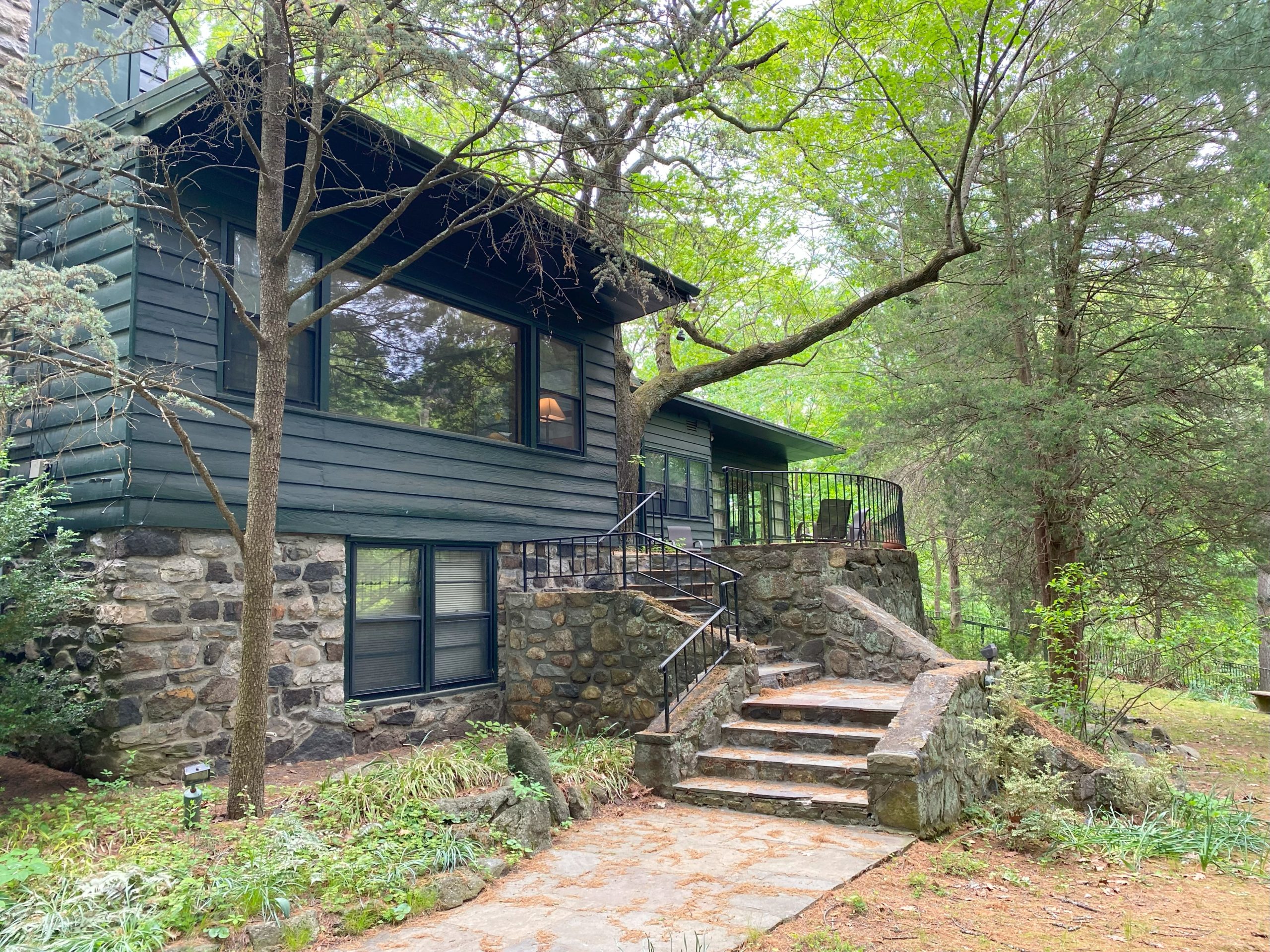
Way back in the mid 1990s when I was in my first wave of Copland mania I found out about Copland House. They were the only organisation I could find on the web at the time. It was the nearest thing to a Copland fan club. I think I paid an annual fee of $5 or $10 dollars and got a newsletter through the post a few times a year. It was called “Letter from Home”.
Rock Hill was Aaron Copland’s house for the last 30 years of his life. It’s in a little hamlet called Cortlandt Manor near Peekskill in upstate New York. I had always wanted to make a pilgrimage there, to see where the man lived and breathe the air that he breathed.
After a third of a century of fandom I finally made the trip this May.
….where America’s musical past and future meet
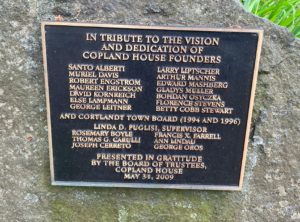 The story of Copland House is one of grit and determination and “working together to bring in the harvest”. It’s the sort of story that would make anyone realise that things can happen if you are prepared to roll up your sleeves and have a go.
The story of Copland House is one of grit and determination and “working together to bring in the harvest”. It’s the sort of story that would make anyone realise that things can happen if you are prepared to roll up your sleeves and have a go.
When Copland died in December 1990 he left the majority of his legacy to set up the Aaron Copland Fund for Music. Rock Hill was in pretty poor shape after around a decade of neglect and the only plan was to sell it and add more money into the fund aimed at promoting American music.
Rewind to when Copland moved to Corlandt Manor in the early 60s, Rock Hill was pretty much the only house there. Over the next three decades many other houses were built so by the time Copland died he had quite a few neighbours, many of whom were involved in or enthusiastic about the creative arts. When they found out about that the prososed course of action was to sell the house, they conceived a plan to raise funds and preserve it as a national monument. The cause was led by an indomitable spirit called Florence Stevens, a former school librarian who organised, petitioned and cajoled and wouldn’t take no for an answer. The local Cordlandt Council and town supervisor Linda Puglisi were brought on board, a long term lease was negotiated and the house was saved.
Since 1998, Copland House has become a mecca for American music – the strapline for the organisation is ….where America’s musical past and future meet. Copland House has been completely preserved so looks like it did when Copland resided there but lives and breathes with new music. Each year it supports American composers with residencies and composer commissions through its Cultivate fellowships. It also has its own house band, Music from Copland House, a crack set of musicians led by pianist and Copland House CEO Michael Boriskin.
This short description only scratches the surface of what Copland House achieves. I encourage everyone to visit their website become a supporter and stay in touch by signing up to the E-letter from home. If you want to take the same tour as me (but virtually) then check out this video on the Copland House Youtube channel:
In conversation with Michael Boriskin

Michael Boriskin with Kevin Lindegaard on the steps of Rock Hill – Copland House.
It’s unusual for me to meet anyone who knows more about Aaron Copland than me. Often, when I say to someone that I write a blog about the American composer Aaron Copland, there is a slightly puzzled expression that then usually evaporates into enlightened understanding when I say “The composer of Fanfare for the Common Man”.
But on this occasion I was lucky to have a personal tour of Copland House with Michael Boriskin himself. I have met Michael online before and had email correspondence on and off for years. It was always obvious to me that Michael was a kindred spirit and he greeted me outside Rock Hill with a hug.
Michael set aside several hours from his busy schedule to show me around, have lunch and chat. These are some of the things we talked about:
Michael showed me the national historic landmark and tribute plaques outside the house. I remarked how I had been very surprised that there is not a statue or a bust or even a street named after Copland in New York City. He agreed with me that this is odd but not unusual. and added that the Europeans are much better than the US at celebrating icons of the past. He suggested that if I really wanted to see a bust of Copland then I would have to go to Tanglewood in Lenox, Massachusetts. (Well, there’s an idea for another trip stateside!)
If you are a Copland afficionado, it’s almost impossible to not want to encourage and support new music. I mentioned my idea of celebrating Copland’s 125th anniversary with an American music festival and how this could incorporate a revival of the Copland Sessions concerts (enabling opportunities for composers under the age of 35 to have their work played). I said that I hated the fact that new music is often no more than an afterthought. I said “If Beethoven were alive today, he wouldn’t have it”. I added “Can you imagine a Beethoven premiere sandwiched in the middle of a first half of a concert? And then for the main event to be a symphony that was written 200 odd years ago? I think Beethoven would blow a fuse!”. Michael mentioned a phrase that I thought just about summed up this conundrum
Classical music is a canon. No one can get into the canon and no one can get out of it for that matter”.
Michael showed me some of the great pictures in Copland’s study and living room. On a couple of occasions, he tested my knowledge on who was in the pictures with Copland. I was pretty chuffed with myself as I manged to identify Martha Graham, Tennessee Williams and Ella Fitzgerald but struggled with the side profile of Henry Fonda (Copland’s fellow recipients of Kennedy Center Honors in 1979). I also managed to pass the test by correctly naming the composers in the great pic featuring Copland, Bernstein, Virgil Thompson, Walter Piston and William Schuman. He said that quite a few people struggled with naming Schuman so I was pleased about that!
I mentioned that I was doing research on Copland dedications, (i.e. pieces that other composers dedicated to Copland) and had found dozens (this will be a future blog – watch this space). I suggested to him that this would be a great project for Music from Copland House – to stage concerts and perhaps a recording of some of the chamber works for the 125th anniversary in 2025. I think Michael liked this idea but, of course he’s incredibly busy and the main mission is to promote new music not old. Still, it would be great if that comes off. Whilst describing a couple of the best dedicated pieces, I made a bit of a fluff and mixed up the names of composers Arthur Berger and Harold Shapero. Oh well!
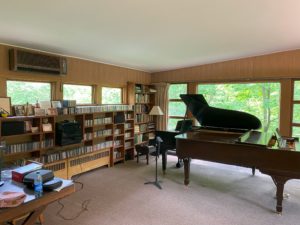 In Copland’s studio there were two grand pianos. I commented that there remains some great Copland works transcribed for two pianos that haven’t been recorded (Symphonic Ode, Piano Concerto and scherzo from the Organ Symphony). I wistfully imagined hearing those played in same the room where Copland had composed at his tiny desk.
In Copland’s studio there were two grand pianos. I commented that there remains some great Copland works transcribed for two pianos that haven’t been recorded (Symphonic Ode, Piano Concerto and scherzo from the Organ Symphony). I wistfully imagined hearing those played in same the room where Copland had composed at his tiny desk.
I loved walking around the grounds. I mentioned that I’m a birder and Michael said that the house frequently gets a Barn Owl swooping in and landing on the porch and looking into the house. I had my binoculars with me but of course it was completely the wrong time of day to see such a magnificent spectacle.
All the while Michael told me loads of lovely anecdotes. There was a story about how on one night after dinner Copland surprised his younger composer friends by donning an apron and doing the dirty dishes. One of the composers (Harold Shepero) some time later was also lucky enough to have a supper engagement with Igor Stravinsky. To his amazement, the great man also got up after the meal and started washing up. Shapero sent Copland a telegram saying
Stravinsky does the dishes!”
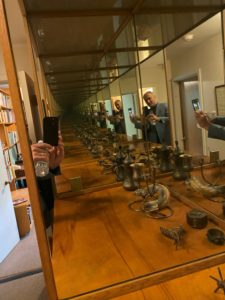
This is where Copland’s Oscar used to be positioned to make it look like he had won dozens!
He then showed me the mirror in the hall where Copland used to keep his Oscar (received for The Heiress in 1949). This was apparently positioned in order to make it look like he had won wall to wall Oscars!
There were stories about the different pictures – for instance, the classic one of Copland and Bernstein hugging and how that was actually a picture with other people in it but they had been cut out.
With regards to things that end up on the cutting room floor – over lunch I ventured my controversial opinion that Copland wasn’t always the best judge of what to leave in and what to leave out of the suite versions of his work. As witness for the prosection, I cited the truncated versions of Appalachian Spring, Our Town and Quiet City as in my view he removed all of the grit. I said that even when Copland modified the music from the Something Wild soundtrack into Music for a Great City, in the Subway Jam section he left out my favourite bit (the staccato percussion that is used when the metro goes through a station). I don’t think Michael was convinced but he heard me out. He said that Copland himself would often use the French word choisi to describe what he published and what he didn’t.
Whilst in the diner I told Michael that this was my first meal in New York that didn’t involve disposal plates, cups and cutlery. I said that for an environmentalist like me that this was really quite tricky and I confided to him that I had earlier taken my breakfast paper plate and plastic knife and fork back to my hotel room so I could use them again! I said that Copland’s music from The City that is used to show off the fast food nature of breakfast in NYC could just as easily be used in a contemporary film clip showing bag after bag of trash being filled and disposed of. (Watch from 14:45 in the clip below.)
We talked about music that was inspiring me/us at the moment. I said that I had been blown away when I heard Four Parables by Paul Schoenfield (an absolutely scintillating piano concerto – the opening piece is called Rambling ‘til the Butcher Cuts us Down and the final piece is called Dog Heaven!) and had been switched on by a recent concert that featured Caroline Shaw. He said that he had been a little bit perplexed when the self-confessed part time composer had won the Pulitzer Prize but added that when he listened to her music, that he had to admit that she really has a special talent.
He gave me a CD and a programme for the 2022/23 season of Music from Copland House concerts at the City University of New York. When I opened it, I was rather disappointed that I hadn’t mentioned my recent discovery – Missy Mazzoli, whose music they had featured in the December concert. If I lived in NYC I would be at all these concerts like a shot. We discussed the possibility of MCH coming to the UK. Michael is very keen on this, so I am keeping my fingers firmly crossed.
The hours flew by and Michael was a wonderful and genial host. He dropped me off at Peekskill Station and we said our so longs. I was off to see the Mahler 9 that night at the Lincoln Centre. As my parting shot I told him that even though I was really looking forward to it, that I would trade the experience in a heartbeat to instead see and hear Symphonic Ode. He gave me a broad smile and said “My kinda guy!”
Acknowledgement
Many thanks also to David Feller, the Administrative Associate at Copland House who picked me up from the station and took the pics of me and Michael.
Date for your diary
Copland House is celebrating it’s 25th anniversary on 30th October with a gala concert in the Lincoln Centre. Get your tickets here.

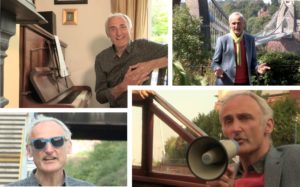
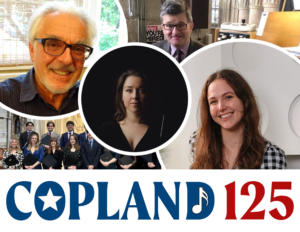






Blog Comments
Michael Boriskin
9th September 2023 at 4:20 pm
Your blog post about Rock Hill and our visit was so well done … really wonderful, a lovely souvenir!
The composer who sent the “Stravinsky dishes” telegram was Harold Shapero … one of those young Boston-based Copland acolytes and mentees who came of age in the 1940s. A really terrific composer. Here’s my recording of his little Sonata #3 from 1944: https://www.youtube.com/watch?v=iPDbSfyx75Q&ab_channel=WelleszTheatre. (The whole thing is all of about 12 minutes!) I’ve recorded his other two, from around the same time, which you can also hear on YouTube. I think you’ll find them delectable! They’re all a kind of quirky cross between Haydn + Scarlatti and Stravinsky + Poulenc!